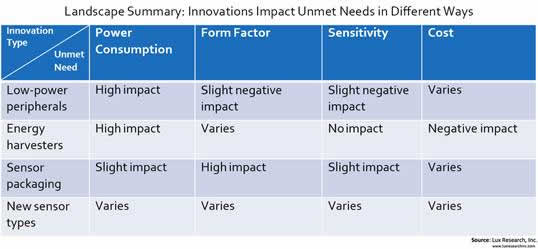Power Savings Lead the Four Top Areas for Sensors Innovation
The proliferation of mobile devices, growing popularity of wearables, and the advent of the connected “Internet of Things” are driving expected demand for sensors into the trillions. However, to achieve the full potential of these products and others, sensors need innovations to address critical unmet needs in power consumption, sensitivity, form factor, and cost, according to Lux Research.
The leading technologies to address these needs include low-power peripherals, energy harvesting, sensor packaging, and new sensor types. Low-power peripherals – the non-sensor portion of the module, like the processor and communication protocols – are the most readily available and the easiest for makers of sensor devices to incorporate because they can be easily manufactured at foundries.
“Cisco has predicted 50 billion connected devices, each with multiple sensors, by 2020, but innovators will need to make drastic improvements to sensors to make this vision a reality,” said Tiffany Huang, Lux Research Associate and lead author of the report titled, “Identifying Key Sensor Innovations Solving Unmet Needs.”
“Investments are flowing into start-ups, and multinational companies like Samsung, Sony, Panasonic, IBM and Ford have invested billions of dollars to drive innovations that fulfill unmet needs in sensors,” she added.
Lux analysts broke down the available and emerging technologies for unmet needs in sensors and found:
• Power performance is improved by two ways. SureCore, Ineda and Ambiq Micro deliver the best power performance, according to an evaluation on the Lux Innovation Grid. Ineda and GainSpan achieve this by decreasing power consumption when devices are not in active use, while Ambiq and PsiKick decrease power use by operating on lower than normal voltages.
• Motion Engine leads in packaging. Integrating all components in a system-in-a-package (SiP) decreases overall size. Innovators like Motion Engine can cram more devices into the same amount of space; other leaders include mCube, Amkor, Bosch and Standing Egg.
• Emerging sensor types. Innovation is taking the industry beyond incumbent capacitive sensors. New sensor types include optical, piezoelectric and thermal, from firms like Xarion, Vesper, and Next Biometrics, respectively.
The report, titled “Identifying Key Sensor Innovations Solving Unmet Needs,” is part of the Lux Research Sensors Intelligence service.


Comments are closed, but trackbacks and pingbacks are open.